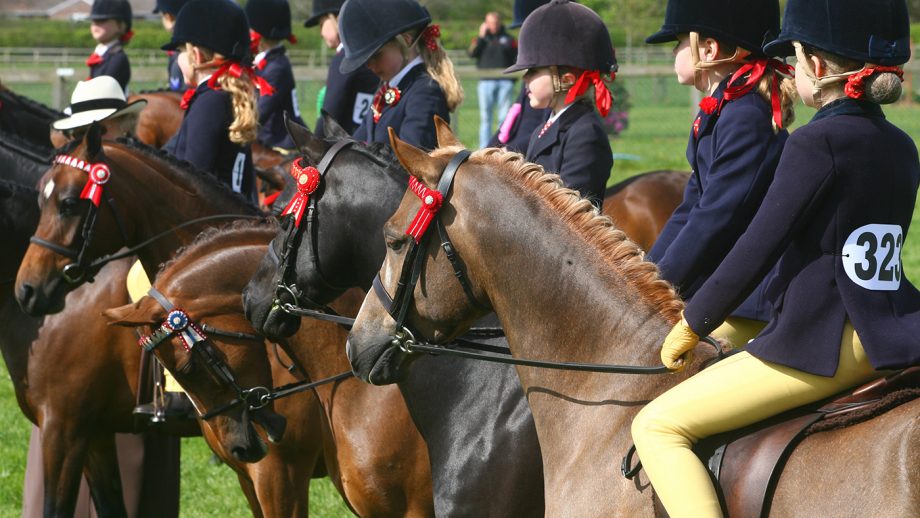Is the mini ridden combination the hardest nut to crack, and how do you produce one to succeed at top level? Tricia Johnson finds out
Britain’s plaited “mini” ponies – lead-rein and first ridden – have long been the envy of the world for their quality and manners, and have also launched stellar careers for riders across the disciplines.
These classes continue to attract huge entries, but priorities appear to have changed in recent years, and today’s picture is not always a pleasant or instructive one. The sight of highly strung mini ponies going in a fixed, overbent outline – unable to walk out correctly – is becoming increasingly common.
{"content":"PHA+U28gd2h5IGlzIHRoaXM\/IFNvbWUgYmVsaWV2ZSB0aGUgdHJlbmQgaGFzIHN3dW5nIHRvbyBmYXIgaW4gZmF2b3VyIG9mIG1vcmUgZmluZWx5IGJyZWQgcG9uaWVzIOKAkyBvZnRlbiBkZXNjcmliZWQgYXMgbWluaSB0aG9yb3VnaGJyZWRzIOKAkyB3aG8gbWF5IHJlcXVpcmUgZXh0ZW5zaXZlIOKAnGRyaWxsaW5n4oCdIGJlZm9yZSBiZWluZyBkZWVtZWQgc2FmZSBlbm91Z2ggdG8gYXBwZWFyIGluIHRoZSByaW5nLiBPdGhlcnMgYmxhbWUgaWdub3JhbmNlIGFuZCBhbiBpbmNyZWFzZWQgZGVtYW5kIGZvciBxdWljayByZXN1bHRzLCBsZWFkaW5nIHRvIGhhc3R5IHByb2R1Y3Rpb24gYW5kIGFuIG92ZXItcmVsaWFuY2Ugb24gZ2FkZ2V0cywgc3VjaCBhcyBzaWRlLXJlaW5zLCB0byBjcmVhdGUgd2hhdCBpcyBiZWxpZXZlZCB0byBiZSB0aGUgZGVzaXJlZCBvdXRsaW5lLjwvcD4KPHA+VGhlIHJlc3VsdGluZyBwaWN0dXJlIGlzIG5vdCBvbmUgdGhhdCBtb3N0IGp1ZGdlcyB3YW50IHRvIHNlZSwgaG93ZXZlci48L3A+CjxwPuKAnEl04oCZcyBlYXN5IHRvIHNwb3QgcG9uaWVzIHRoYXQgbWF5IGhhdmUgYmVlbiB3b3JrZWQgaW4gdGFjayBvciBwcm9kdWNlZCBpbnRvIGEgZmFsc2Ugb3V0bGluZSzigJ0gc2F5cyBsZWFkaW5nIGp1ZGdlIEphY2tpZSBCZWF0aGFtLiDigJxNeSBmaXJzdCBpbXByZXNzaW9uIGlzIGFsd2F5cyB0aGUgd2FsayDigJMgZG9lcyB0aGUgY29tYmluYXRpb24gb2YgcG9ueSBhbmQgcmlkZXIgbG9vayBoYXBweSBhbmQgcmVsYXhlZD8gSXMgdGhlIHBvbnkgc2hvd2luZyBtZSBhIGNvcnJlY3QgZm91ci10aW1lIGJlYXQgd2l0aCBhbiBvdmVydHJhY2ssIGFuZCBpcyBpdHMgaGVhZCBoZWxkIHNsaWdodGx5IGluIGZyb250IG9mIHRoZSB2ZXJ0aWNhbD88L3A+CjxwPjxkaXYgY2xhc3M9ImFkLWNvbnRhaW5lciBhZC1jb250YWluZXItLW1vYmlsZSI+PGRpdiBpZD0icG9zdC1pbmxpbmUtMiIgY2xhc3M9ImlwYy1hZHZlcnQiPjwvZGl2PjwvZGl2PjxzZWN0aW9uIGlkPSJlbWJlZF9jb2RlLTMxIiBjbGFzcz0iaGlkZGVuLW1kIGhpZGRlbi1sZyBzLWNvbnRhaW5lciBzdGlja3ktYW5jaG9yIGhpZGUtd2lkZ2V0LXRpdGxlIHdpZGdldF9lbWJlZF9jb2RlIHByZW1pdW1faW5saW5lXzIiPjxzZWN0aW9uIGNsYXNzPSJzLWNvbnRhaW5lciBsaXN0aW5nLS1zaW5nbGUgbGlzdGluZy0tc2luZ2xlLXNoYXJldGhyb3VnaCBpbWFnZS1hc3BlY3QtbGFuZHNjYXBlIGRlZmF1bHQgc2hhcmV0aHJvdWdoLWFkIHNoYXJldGhyb3VnaC1hZC1oaWRkZW4iPg0KICA8ZGl2IGNsYXNzPSJzLWNvbnRhaW5lcl9faW5uZXIiPg0KICAgIDx1bD4NCiAgICAgIDxsaSBpZD0ibmF0aXZlLWNvbnRlbnQtbW9iaWxlIiBjbGFzcz0ibGlzdGluZy1pdGVtIj4NCiAgICAgIDwvbGk+DQogICAgPC91bD4NCiAgPC9kaXY+DQo8L3NlY3Rpb24+PC9zZWN0aW9uPjwvcD4KPHA+4oCcSSBhbSBmaXJzdCBhbmQgZm9yZW1vc3QgbG9va2luZyBmb3IgYSBwb255IHdpdGggdGhlIHN1aXRhYmlsaXR5IGFuZCBtYW5uZXJzIHRvIGRvIHRoZSBqb2IsIGFuZCBzb21ldGltZXMgdGhpcyBtZWFucyBoYXZpbmcgdG8gZm9yZmVpdCBhIGxpdHRsZSBxdWFsaXR5IHRvIGFjaGlldmUgdGhlIGNvcnJlY3QgcmVzdWx0LuKAnTwvcD4KPHA+RmVsbG93IGp1ZGdlIEpvYW5uZSBHcmlmZmluIGNvbmN1cnMuIOKAnFN1aXRhYmlsaXR5IGlzIGEgd29yZCB0aGF0IHNlZW1zIHRvIGhhdmUgYmVlbiBmb3Jnb3R0ZW4s4oCdIHNoZSBzYXlzLiDigJxIb3dldmVyLCB3aXRoIHRpbWUgYW5kIHBhdGllbmNlLCBpdCBzaG91bGQgYmUgcG9zc2libGUgdG8gaGF2ZSBib3RoIHRlbXBlcmFtZW50IGFuZCBxdWFsaXR5LiBTYWRseSwgdG9vIG1hbnkgcGVvcGxlIG5vdyB3YW50IGluc3RhbnQgc3VjY2VzcyBhbmQgdGFrZSBzaG9ydCBjdXRzIHRvIHRyeSB0byBhY2hpZXZlIGl0LuKAnTwvcD4KPHA+VGhlIGJhbGFuY2UgYmV0d2VlbiBoYXZpbmcgYSBwb255IHdpdGggc3VmZmljaWVudCBxdWFsaXR5IGF0IHRoZSB0b3Agb2YgaXRzIGdhbWUsIGJ1dCByZWxpYWJsZSBlbm91Z2ggdG8gYmUgcmlkZGVuIGJ5IGEgY2hpbGQg4oCTIHBlcmhhcHMgYXMgeW91bmcgYXMgdGhyZWUg4oCTIGlzIGEgdHJpY2t5IG9uZSwgc28gY2hvb3NpbmcgdGhlIGNvcnJlY3Qg4oCccmF3IG1hdGVyaWFs4oCdIHNob3VsZCB0aGVyZWZvcmUgYmUgYSBoaWdoIHByaW9yaXR5LjwvcD4KPGRpdiBjbGFzcz0iYWQtY29udGFpbmVyIGFkLWNvbnRhaW5lci0tbW9iaWxlIj48ZGl2IGlkPSJwb3N0LWlubGluZS0zIiBjbGFzcz0iaXBjLWFkdmVydCI+PC9kaXY+PC9kaXY+CjxwPuKAnEZvciBtZSwgaXQgaXMgYWJvdXQgcGFpcmluZyB0aGUgY29ycmVjdCBwb255IHdpdGggdGhlIGFiaWxpdHkgYW5kIGRpc3Bvc2l0aW9uIG9mIGVhY2ggY2hpbGQs4oCdIHNheXMgcG9ueSBwcm9kdWNlciBKdWxpZSBUZW1wbGV0b24uIOKAnEluIGFuIGlkZWFsIHdvcmxkLCBldmVyeW9uZSB3b3VsZCBzdHJpdmUgdG8gaGF2ZSB0aGUgbW9zdCBiZWF1dGlmdWwgcG9ueSB3aXRoIGFuIGFtYXppbmcgdGVtcGVyYW1lbnQ7IGhvd2V2ZXIsIGp1c3QgbGlrZSBodW1hbnMsIHBvbmllcyBoYXZlIGRpZmZlcmluZyBwZXJzb25hbGl0aWVzIGFuZCBub3QgZXZlcnkgYW5pbWFsIOKAkyBubyBtYXR0ZXIgaG93IHdlbGwtYnJlZCDigJMgaXMgYWN0dWFsbHkgc3VpdGFibGUuPC9wPgo8cD7igJxUaGVuLCBzb21lIGNoaWxkcmVuIGFyZSBuYXR1cmFsbHkgdGFsZW50ZWQgYW5kIG90aGVycyBhcmUgdmVyeSBicmF2ZTsgc29tZSBsaWtlIGEgZm9yd2FyZC1nb2luZyBhbmltYWwgYnV0IG90aGVycyBwcmVmZXIgdG8ga2ljazsgc29tZSBtYXkgb25seSByaWRlIG9uY2UgYSB3ZWVrIHdoaWxlIG90aGVycyBtYXkgY29tcGV0ZSBpbiBzZXZlcmFsIGRpc2NpcGxpbmVzLjwvcD4KPGRpdiBjbGFzcz0iYWQtY29udGFpbmVyIGFkLWNvbnRhaW5lci0tbW9iaWxlIj48ZGl2IGlkPSJwb3N0LWlubGluZS00IiBjbGFzcz0iaXBjLWFkdmVydCI+PC9kaXY+PC9kaXY+CjxwPuKAnEJ1dCwgaWYgeW91ciByYXcgaW5ncmVkaWVudHMgYW5kIHBhdGllbmNlIGFyZSBnb29kIGVub3VnaCwgeW91IHNob3VsZG7igJl0IG5lZWQgdG8gdXNlIGdhZGdldHMu4oCdPC9wPgo8cD5GZWxsb3cgcHJvZHVjZXIgYW5kIG1pbmkgc3BlY2lhbGlzdCBTaGFybiBMaW5uZXkgYWdyZWVzLiDigJxJIGFtIGEgc3Ryb25nIGJlbGlldmVyIHRoYXQgdGhlcmUgaXMgYSBwb255IG91dCB0aGVyZSBmb3IgZXZlcnlvbmUsIGJ1dCBzb21ldGltZXMgc2hvd2luZyBpcyBub3QgZm9yIGV2ZXJ5IHBvbnks4oCdIHNoZSBzdHJlc3Nlcy4g4oCcVGhlcmUgYXJlIHNvIG1hbnkgb3RoZXIgZGlzY2lwbGluZXMgcG9uaWVzIGNhbiBkby48L3A+CjxkaXYgY2xhc3M9ImFkLWNvbnRhaW5lciBhZC1jb250YWluZXItLW1vYmlsZSI+PGRpdiBpZD0icG9zdC1pbmxpbmUtNSIgY2xhc3M9ImlwYy1hZHZlcnQiPjwvZGl2PjwvZGl2Pgo8cD7igJxEcmlsbGluZyB0aGVtIHdpdGggd29yayBpbiBvcmRlciBmb3IgdGhlbSB0byBwZXJmb3JtIGluIHRoZSByaW5nIGlzIG5vdCB0aGUgYW5zd2VyIOKAkyB0aGV5IGhhdmUgdG8gYmUgZW5qb3lpbmcgdGhlbXNlbHZlcyBhcyBpdCByZWFsbHkgZG9lcyBzaG93LiBBIHBvbnkgZ29pbmcgZnJlZWx5IHdpdGggaXRzIGVhcnMgZm9yd2FyZCBpcyBtdWNoIG1vcmUgYXBwZWFsaW5nIHRoYW4gb25lIHdpdGggYSBuZWdhdGl2ZSBhdHRpdHVkZSwgc2l0dGluZyBiZWhpbmQgdGhlIGJyaWRsZS7igJ08L3A+CjxoMz5UaGUgZWx1c2l2ZSBwZXJmZWN0IHBpY3R1cmU8L2gzPgo8cD5Qcm9kdWNpbmcgbWluaSBwb25pZXMgdGVzdHMgc2tpbGxzIHRvIHRoZSB1dG1vc3QsIHNvIGhvdyBkbyB5b3UgYWNoaWV2ZSB0aGF0IGVsdXNpdmUgcGVyZmVjdCBwaWN0dXJlPyBHYXlsZSBIb2xkZXIsIHdobyB3aXRoIGhlciBkYXVnaHRlciBFbW1hIHByb2R1Y2VzIGFsbCB0eXBlcyBvZiBwb25pZXMgYW5kIGhvcnNlcyBhdCB0aGUgZmFtaWx54oCZcyBTdXJyZXkgYmFzZSwgYmVsaWV2ZXMgdGhhdCBtYW5hZ2VtZW50IHByYWN0aWNlcyBwbGF5IGFuIGltcG9ydGFudCByb2xlLjwvcD4KPHA+4oCcSSBoYXZlIG5vdCBmb3VuZCB0aGF0IHF1YWxpdHkgbmVjZXNzYXJpbHkgaGFzIGFueXRoaW5nIHRvIGRvIHdpdGggdGVtcGVyYW1lbnQs4oCdIHNoZSBzYXlzLiDigJxBIGdvb2QgYmFzaWMgdGVtcGVyYW1lbnQgYW5kIGNvcnJlY3QgcHJvZHVjdGlvbiDigJMgaW5jbHVkaW5nIHBsZW50eSBvZiBmaWVsZCB0aW1lIGFuZCBoYWNraW5nIGFzIHdlbGwgYXMgc2Nob29saW5nIOKAkyBhcmUgd2hhdCBtYXR0ZXIgbW9zdC4gSWYgeW91IHJlc3RyaWN0IHBvbmllcyB0b28gbXVjaCwgdGhleSBiZWNvbWUgc291ciBhbmQgc2hhcnAu4oCdPC9wPgo8cD5Nb3N0IHByb2R1Y2VycyBhZ3JlZSB0aGF0IGluIG9yZGVyIHRvIGZpbmQgdGhhdCBrZXksIHBvbmllcyBzaG91bGQgYmUgdHJlYXRlZCBhcyB0aGUgaW5kaXZpZHVhbHMgdGhleSBhcmUuIFRoZXkgYWxzbyBzdHJlc3MgdGhhdCBhbGxvd2luZyBzdWZmaWNpZW50IHRpbWUgaXMgdml0YWwuPC9wPgo8cD7igJxUb28gbWFueSBwb25pZXMgYXJlIGJyb2tlbiB0b28gcXVpY2tseSBhbmQgZ28gc3RyYWlnaHQgZnJvbSB0aGUgc2Nob29sIHRvIHRoZSByaW5nIHdpdGggbm8gaW5zaWdodCBhYm91dCB0aGUgb3V0c2lkZSB3b3JsZCzigJ0gYWRkcyBHYXlsZS4g4oCcT3VycyBhcmUgYWxsIGxvbmctcmVpbmVkIHJvdW5kIHRoZSB2aWxsYWdlIGFuZCBiZXlvbmQg4oCTIGVzcGVjaWFsbHkgdGhlIGxlYWQtcmVpbnMgYW5kIGZpcnN0IHJpZGRlbnMg4oCTIGJlZm9yZSBiZWluZyBzYXQgb24uPC9wPgo8cD7igJxBZnRlciB0aGV5IGNhbiB3YWxrIGFuZCB0cm90IGFyb3VuZCB0aGUgc2Nob29sIHdpdGggYSByaWRlciBvbiBib2FyZCwgd2UgdGFrZSB0aGVtIG91dCBoYWNraW5nIGZvciB0aGUgbmV4dCBmZXcgd2Vla3M7IHdlIGFyZSB2ZXJ5IGx1Y2t5IHRvIGhhdmUgbG90cyBvZiBiZWF1dGlmdWwgc2FuZHkgdHJhY2tzIGFyb3VuZCB1cy4gT25jZSB0aGUgZmllbGRzIGFyZSBkcnksIHdlIGhhcmRseSBldmVyIHdvcmsgaW4gdGhlIHNjaG9vbCDigJMgYXMgd2VsbCBhcyB0aGlzIGJlaW5nIGJldHRlciBmb3IgdGhlIHBvbmllcywgd2UgYWxzbyBiZWxpZXZlIHRoZSBqb2NrZXlzIHdpbGwgbmV2ZXIgY29wZSB3aXRoIGEgYmlnIGdyYXNzIHJpbmcgdW5sZXNzIHRoZXkgY2FuIHJpZGUgaW4gdGhlIGZpZWxkLjwvcD4KPHA+4oCcSXTigJlzIGp1c3QgYXMgaW1wb3J0YW50IHRoYXQgdGhlIHJpZGVycyBoYXZlIGVub3VnaCB0aW1lIGluIHRoZSBzYWRkbGUgYW5kIHJlZ3VsYXIgbGVzc29ucyBvbiB0aGUgcG9uaWVzIHRoZXkgYXJlIGNvbXBldGluZzsgaXQgdGFrZXMgdGltZSB0byBidWlsZCBhIHJlbGF0aW9uc2hpcCB3aXRoIGFueSBhbmltYWwuPC9wPgo8cD7igJxXZSBhbHNvIHRyeSBub3QgdG8gZ2V0IHRoZSBtaW5pIHBvbmllcyB0b28gZml0IGFuZCBpZiB0aGV5IG5lZWQgbW9yZSB0b3Agb3IgYm90dG9tLCB0aGF0IGNvbWVzIGRvd24gdG8gbWUgd2l0aCBnb29kIG9sZC1mYXNoaW9uZWQgc3RyYXBwaW5nLOKAnSBzaGUgc2F5cy48L3A+CjxwPllvcmtzaGlyZS1iYXNlZCBTYXJhIFBhcnJvdHQsIHdobyBwcm9kdWNlcyBzaG93IGFuaW1hbHMgb2YgdmFyaW91cyB0eXBlcyB3aXRoIHBhcnRuZXIgQ3JhaWcgRWxlbm9yLCBtYW5hZ2VzIG1vc3Qgb2YgdGhlbSBpbiBhIHNpbWlsYXIgd2F5LjwvcD4KPHA+4oCcT3VyIG1pbmkgcG9uaWVzIGFyZSBicm9rZW4gaW4sIHdvcmtlZCBhbmQgcHJvZHVjZWQgZXhhY3RseSB0aGUgc2FtZSBhcyB3ZSB3b3VsZCB0aGUgYmlnZ2VyIGhvcnNlcyBvciBwb25pZXMs4oCdIHNoZSBzYXlzLiDigJxXZSB3YW50IHRoZW0gYWxsIHRvIHdvcmsgZnJvbSBiZWhpbmQgaW50byBhIGxpZ2h0IGNvbnRhY3QsIGFuZCBpbiBhbnkgY2FzZSwgY2hpbGRyZW4gY2Fu4oCZdCBsZWFybiDigJhmZWVs4oCZIGlmIHRoZXkgaGF2ZSBub3RoaW5nIGluIHRoZWlyIGhhbmQuIFRoZXJlZm9yZSB3ZSBwcm9kdWNlIG91ciBwb25pZXMgd2l0aCB0aGlzIGluIG1pbmQu4oCdPC9wPgo8aDM+U2FmZWd1YXJkaW5nIHBvbnkgd2VsZmFyZTwvaDM+CjxwPlRoZSBzdWl0YWJpbGl0eSBvZiByaWRlcnMgaGFzIGJlZW4gaGlnaGxpZ2h0ZWQgaW4gcmVjZW50IHllYXJzLCB0b28sIHdpdGggbWFueSBzaG93cyBub3cgcG9saWNpbmcgcnVsZXMgZ292ZXJuaW5nIHRoZSBhZ2UsIHdlaWdodCDigJQgb3IgYm90aCDigJQgb2YgcGVvcGxlIHdvcmtpbmctaW4gc21hbGwgcG9uaWVzIGFueXdoZXJlIG9uIHRoZSBzaG93Z3JvdW5kLiBBbHRob3VnaCB0aGlzIGlzIGNsZWFybHkgaW50ZW5kZWQgdG8gc2FmZWd1YXJkIHBvbmllc+KAmSB3ZWxmYXJlLCBpdCBpcyBub3QgbmVjZXNzYXJpbHkgYXMgY2xlYXItY3V0IGFzIHNvbWUgcGVvcGxlIGltYWdpbmUuIEEgcG9ueSB0aGF0IGlzIHdlbGwgYmVoYXZlZCBhdCBob21lIGNhbiBiZSB1bnByZWRpY3RhYmxlIGluIHRoZSBidXp6eSBhdG1vc3BoZXJlIG9mIGEgYmlnIHNob3csIGFuZCBwYXJ0aWN1bGFybHkgaWYgbHVuZ2VpbmcgaXMgbm90IHBlcm1pdHRlZCBvbiB0aGUgc2hvd2dyb3VuZCwgc29tZSBtaW5pcyBjYW4gcHJvdmUgdG9vIG11Y2ggZm9yIGEgc21hbGwgY2hpbGQuPC9wPgo8cD7igJxTYWZldHkgaGFzIHRvIGJlIGtleTogYWZ0ZXIgYWxsLCB3ZSBjYW4gcmVwbGFjZSBhIHBvbnksIGJ1dCBub3QgYSBjaGlsZCzigJ0gSnVsaWUgcG9pbnRzIG91dC4g4oCcVW5saWtlIG1vc3QgaG9yc2VzLCBzb21lIHBvbmllcyBhcmUgbWlja2V5LXRha2VycyDigJMgcmF0aGVyIGxpa2UgdG9kZGxlcnMg4oCTIHNvIGlmIHlvdSBnaXZlIHRoZW0gYW4gaW5jaCwgdGhleeKAmWxsIHRha2UgYSBtaWxlLOKAnSBhZGRzIEdheWxlLiDigJxBbHRob3VnaCBJIGRvbuKAmXQgYWdyZWUgd2l0aCBvdmVyd2VpZ2h0IHJpZGVycyBvbiBzbWFsbCBwb25pZXMsIGFuIGV4cGVyaWVuY2VkLCBzbWFsbCwgbGlnaHR3ZWlnaHQgYWR1bHQgY2FuIG9mdGVuIGhlbHAga2VlcCBhIHBvbnkgb24gdGhlIHN0cmFpZ2h0IGFuZCBuYXJyb3csIHdoaWNoIGlzIGJlbmVmaWNpYWwgZm9yIGJvdGggdGhlIHBvbnkgYW5kIGl0cyB1bHRpbWF0ZSBqb2NrZXkuIFBsdXMsIEkgYmVsaWV2ZSB0aGF0IHdlbGwtc2Nob29sZWQgcG9uaWVzIGhlbHAgdG8gbWFrZSBnb29kIGFuZCB1c3VhbGx5IHN5bXBhdGhldGljIHJpZGVycyB3aXRoIGdvb2QgaGFuZHMu4oCdPC9wPgo8cD5FcXVhbGx5IHRyaWNreSBpcyB0aGUgc3RlcCB1cCBmcm9tIGxlYWQtcmVpbiB0byBmaXJzdCByaWRkZW4gcmFua3MsIHdoZXJlIHN1aXRhYmlsaXR5IGFuZCBjb3JyZWN0IHByb2R1Y3Rpb24gY2FuIGJlIGV2ZW4gbW9yZSBwcm9ibGVtYXRpYyBhcyB0aGUgY2hpbGRyZW4g4oCcZmx5IHNvbG\/igJ0gZm9yIHRoZSBmaXJzdCB0aW1lLjwvcD4KPHA+4oCcSWYgdGhpcyBzdGVwIGlzbuKAmXQgbWFkZSBjb3JyZWN0bHksIHdlIHdpbGwgbG9zZSBhbGwgb3VyIGZ1dHVyZSBqb2NrZXlzLOKAnSBKb2FubmUgR3JpZmZpbiBpbnNpc3RzLjwvcD4KPHA+4oCcVGhlIGZpcnN0IHJpZGRlbiBpcyBwcm9iYWJseSB0aGUgbW9zdCBpbXBvcnRhbnQgcG9ueSBhbnkgcGFyZW50IGNhbiBidXks4oCdIGFncmVlcyBQYXQgUGF0dGluc29uLCBqdWRnZSBhbmQgY2hhaXIgb2YgdGhlIEJyaXRpc2ggU2hvdyBQb255IFNvY2lldHkuIOKAnEl0IHNob3VsZCBiZSBzYWZlLCBzb3VuZCBpbiBtaW5kIGFuZCBib2R5LCBhbmQgcHJvdmlkZSBsb3RzIG9mIGZ1bi4gSXQgc2hvdWxkIGJ1aWxkIGEgY2hpbGTigJlzIGNvbmZpZGVuY2Ugc28gdGhleSBjYW4gZW5qb3kgaXQgYW5kIGdvIG9uLCBhbmQgaG9wZWZ1bGx5IGl0IHdpbGwgYmUgcHJvZHVjZWQgd2l0aCB0aGlzIGluIG1pbmQu4oCdPC9wPgo8aDM+Q3VycmVudCDigJhmYXNoaW9uc+KAmTwvaDM+CjxwPkRyZXNzYWdlIHJpZGVyIEpvZGllIFBoaWxsaXBzIChuw6llIExpc3RlcikgaXMgb25lIG9mIG1hbnkgd2hvIHN0YXJ0ZWQgb2ZmIGluIHBsYWl0ZWQgcG9ueSByYW5rcywgaW4gaGVyIGNhc2UgcHJvZ3Jlc3NpbmcgZnJvbSB0b3AtbGV2ZWwgc2hvd2luZyB0byBtZWRhbC13aW5uaW5nIGp1bmlvciBhbmQgeW91bmcgcmlkZXIgdGVhbXMsIGFjaGlldmluZyBpbnRlcm5hdGlvbmFsIHN1Y2Nlc3MgYXQgZ3JhbmQgcHJpeCBsZXZlbC4gU2hlIGhhcyBhbHNvIGp1ZGdlZCB0aGUgcG9ueSBzdXByZW1lIGF0IEhpY2tzdGVhZC48L3A+CjxwPlNoZSBpcyBhbm90aGVyIHdobyBiZWxpZXZlcyBjdXJyZW50IOKAnGZhc2hpb25z4oCdIG1heSBhZHZlcnNlbHkgYWZmZWN0IHJpZGVycyBpbiB0aGUgZnV0dXJlLjwvcD4KPGRpdiBjbGFzcz0iaW5qZWN0aW9uIj48L2Rpdj4KPHA+4oCcSWYganVkZ2VzIHJld2FyZCBwb25pZXMgdGhhdCBhcmUgb3Zlci1wcm9kdWNlZCwgYXJlIHRoZXkgbm90IHRha2luZyBhd2F5IHRoZSBvcHBvcnR1bml0eSBmb3IgdGhlIG5leHQgZ2VuZXJhdGlvbiBvZiB5b3VuZyByaWRlcnMgdG8gbGVhcm4gdGhlIGNvcnJlY3Qgc2NhbGVzIG9mIHRyYWluaW5nIGFuZCBleHBlcmllbmNlIGEgZnJlZS1tb3ZpbmcsIGNvcnJlY3RseSB0cmFpbmVkIHBvbnk\/4oCdIHNoZSBwb25kZXJzLiDigJxJbnN0ZWFkLCBpdCBhcHBlYXJzIHRoZXNlIGNoaWxkcmVuIHdpbGwgb25seSBkZXZlbG9wIGEgZmVlbCBmb3IgcG9uaWVzIHRoYXQgYXJlIGJsb2NrZWQgdGhyb3VnaCB0aGVpciBib2R5LCBhbmQgc3RheSBiZWhpbmQgdGhlIGxlZy48L3A+CjxwPuKAnFN1cmVseSB0aGlzIGlzIG5vdCB0aGUgcmlnaHQgcGF0aCBmb3IgY2hpbGRyZW4gd2hvIGNvdWxkIHBvdGVudGlhbGx5IGJlIHRoZSBmdXR1cmUgZ2VuZXJhdGlvbiBvZiBPbHltcGljIG1lZGFsIHdpbm5lcnM\/4oCdPC9wPgo8cD48ZW0+UmVmIEhvcnNlICZhbXA7IEhvdW5kOyAyNiBNYXJjaCAyMDIwPC9lbT48L3A+CjxwPgo="}
This site is protected by reCAPTCHA and the Google Privacy Policy and Terms of Service apply.

